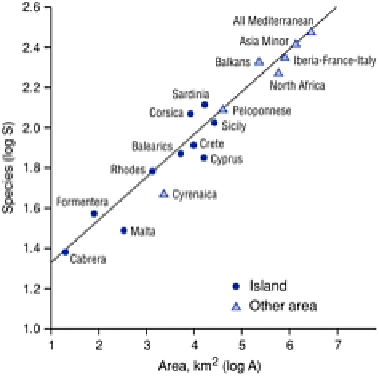Environmental Engineering Reference
In-Depth Information
Figure 1
The relationship between bird species and area for
Mediterranean islands and mainland regions.
After Blondel and Aronson 2000.
mate rule of thumb, if an area increases by a factor of ten, the number of species
doubles. Figure 1 shows how the size of bird populations on Mediterranean islands is
positively correlated with the size of the island. Two factors appear to explain this. First,
the larger the island, the more space there is for larger populations of each species, and
hence there will be lower rates of extinction. Thus there are often very large populations
of the fewer species ('density inflation'). Secondly, larger islands usually have greater
habitat diversity, and therefore can support a wider range of species. The successful in-
migrants are usually those species which can successfully colonize a range of habitats
('generalists') rather than being specialized in one habitat; species on islands often
occupy more ecological space than their equivalents on the mainland ('niche
enlargement').
Ecologists have noted that island populations tend to be of different body size from
mainland organisms; the small are larger, and the large are smaller ('van Valen's rule').
Though there are many exceptions, famous examples were the Pleistocene mammals of
the larger Mediterranean islands such as Cyprus and Crete, where there were elephant the
size of bullocks and hippopotamus the size of pigs. Lack of predators appears to be the
major factor.
Islands are prized because of their unique ecology and rare species. Yet human actions
have often decimated their unique wildlife, whether deliberately or indirectly. About 75
per cent of animal extinctions since AD 1600 have occurred on islands where there is
'nowhere to run'. Extinction through hunting is well documented in many islands such as
Madagascar
Mauritius
and
New
Zealand
but
the
United
Nations
Environment






